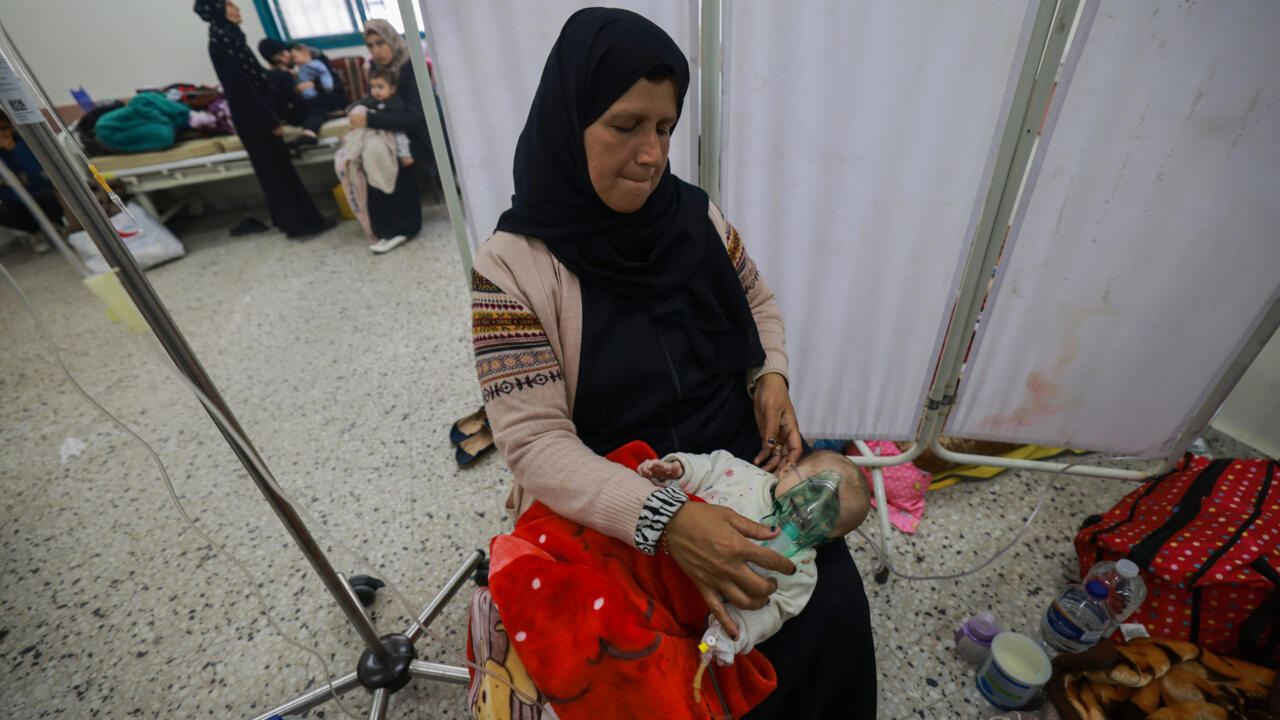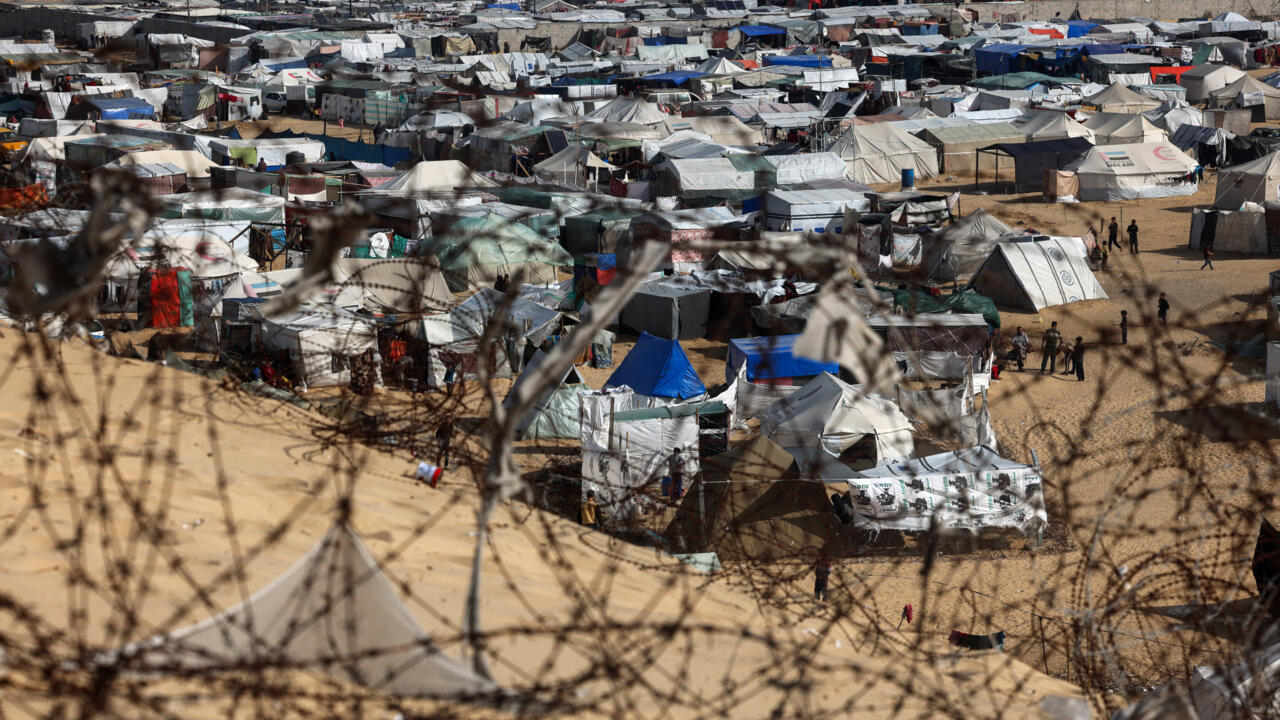

At least 20 people have died from malnutrition and dehydration in Gaza, the enclave’s Hamas-run health ministry said on Wednesday. It reported that most of those dead are children. With limited access to food and healthcare, aid officials have warned for months that Palestinians in the enclave are at risk of famine.
Issued on:
5 min
Advertising
Famine is becoming a real threat for Gazans, exhausted by five months of war. At least 20 people have died from malnutrition and dehydration, the Hamas-run health ministry in Gaza reported Wednesday.
Representatives of the World Health Organization (WHO) in recent days have visited hospitals in the north of the enclave for the first time since the conflict broke out in October 2023. The workers found “severe levels of malnutrition, children dying of starvation, serious shortages of fuel, food and medical supplies, hospital buildings destroyed”, WHO chief Tedros Adhanom Ghebreyesus said on Monday.
Grim findings during @WHO visits to Al-Awda and Kamal Adwan hospitals in northern #Gaza: severe levels of malnutrition, children dying of starvation, serious shortages of fuel, food and medical supplies, hospital buildings destroyed.
The visits over the weekend were the first… pic.twitter.com/CxaCuau7iR
— Tedros Adhanom Ghebreyesus (@DrTedros) March 4, 2024
Famine is defined by the UN as “a situation in which a substantial proportion of the population of a country or region are unable to access adequate food, resulting in widespread acute malnutrition and loss of life by starvation and disease”.
It has warned that a famine is “almost inevitable” for the 2.2 million inhabitants of Gaza.
90 percent of children between six and 23 months old as well as pregnant and breastfeeding women are facing severe food poverty across the territory, according to a report released in February by the Global Nutrition Cluster, a network of NGOs led by UNICEF.
Aid organisations on the ground blame Israel for preventing enough food trucks from entering the enclave.
Read moreMalnourished, sick and scared: Pregnant women in Gaza face ‘unthinkable challenges’
President Joe Biden on Thursday ordered the US military to open a temporary aid port off the coast of Gaza.
On Friday, European Commission President Ursula von der Leyen said a maritime aid corridor between Cyprus and Gaza could open as soon as this weekend.
FRANCE 24 spoke to Jean-Raphaël Poitou, regional director for Action Against Hunger in the Middle East, who says Palestinians in northern Gaza have “nothing left to eat”.
He says if aid continues to be as limited as it is now, the death toll linked to food poverty in the enclave “could rise sharply” in the coming weeks.
Are we talking about an ongoing famine in Gaza or a risk of famine?
Jean-Raphaël Poitou: We are starting to see people, particularly children, die of malnutrition. So yes, we are talking about famine or at the very least, an advanced risk of famine.
To determine whether a famine is ongoing, the UN relies on criteria given by the Integrated Food Security Phase Classification (IPC). The IPC is a standardised system developed by the FAO and other international organisations used to classify and communicate the level of famine or food security in a given context.
A report published back in December had already warned of extremely advanced risks in several areas of Gaza. On a scale of five levels of food insecurity, we reached level three [crisis level]. Given that aid is still lacking, it is normal that three months later, the ranking has moved up to levels four or five [emergency and famine, respectively] – the highest ranking.
Children are particularly vulnerable because their immune systems are not yet fully developed, so their bodies cannot defend themselves the way adult bodies can. We also need to take into account all the elements that accelerate severe malnutrition, like the lack of drinking water, degraded sanitary conditions, respiratory problems and an entirely destroyed access to healthcare. Malnutrition has long-term effects for children, especially on their brains. That is why children under five are prioritised – their brains are not yet fully developed.
Northern Gaza is one of the areas worst hit by malnutrition. What do they have left to eat?
They have nothing left to eat. When we speak to colleagues on the ground, they say Gazans will eat anything, even grass or leaves. Dozens of UN missions have tried entering the north of the enclave, but according to the latest figures, the Israeli army has only accepted 20 percent of the 77 requests made.
Food is unaffordable in Rafah, southern Gaza. Not enough aid is making it through and little has improved in that regard. The attacks on aid convoys show that people are in total desperation to find the food they need to survive.
Read more‘Flour massacre’: Lifesaving aid becomes a deadly struggle in Gaza
It complicates our work in the field. We cannot put our teams at risk, so we have to work on a much smaller scale with communities we know well. Our aid distributions generally include chickpeas, oil or flour, since bread is a staple food. We also used to distribute vegetables when crops were still available in the fields.
When thinking of famines, people often conjure up the terrible images of emaciated children in Somalia during the early 1990s. Is that something we could see happening in Gaza?
It is true that it is not common to see those kinds of images in a Middle Eastern context, but that is what is happening in Gaza right now. And we’re likely to see more and more of them.
We cannot deliver aid on a large scale and we cannot organise distributions without a ceasefire. But we do have solutions and protocols for treating extreme cases of malnutrition like peanut-based foods, which are very rich in calories. They allow children to recover and halt the process of malnutrition.
Still, we need access to these populations. If we do nothing in the meantime, people will starve to death and the number of victims will start to spike.
Last weekend, the US airdropped food and other humanitarian aid into Gaza. Is this a tenable solution to compensate the lack of trucks entering the enclave?
In our point of view, this is not the method to use. We know from experience small groups can hijack parachutes and that the method encourages criminality. What’s more, those most vulnerable won’t be able to access that aid, only the strongest will be able to collect it. That is why we do not encourage this practice at all. We really need to work on a diplomatic level to open up different aid access routes and ensure it is properly distributed.
- At least 20 percent of households face extreme lack of food
- At least 30 percent of children suffer from acute malnutrition
- Two people for every 10,000 die each day due to outright starvation or to the interaction of malnutrition and disease
This article is a translation of the original version in French.
EMEA Tribune is not involved in this news article, it is taken from our partners and or from the News Agencies. Copyright and Credit go to the News Agencies, email [email protected] Follow our WhatsApp verified Channel









